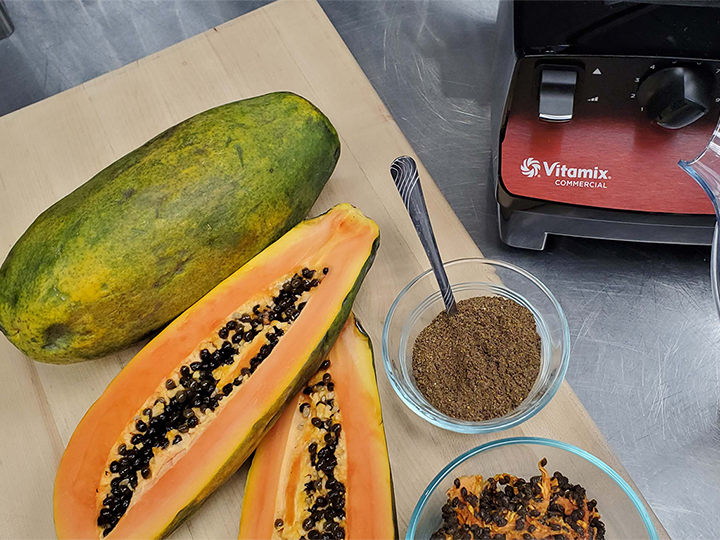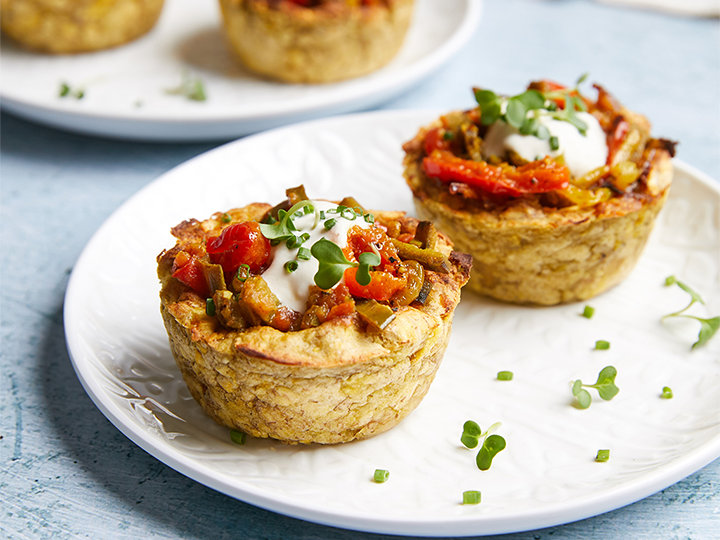Chefs are innovating their kitchens by experimenting with upcycling, which essentially translates to utilizing the whole plant.
“I have been motivated to discover creative uses for food and ingredients that usually end up in the trash bin. From peels and seeds to stems, stalks and leaves, I use as much of each plant as possible, and the result has been new flavors with nutritious benefits,” chef Alejandra Schrader says. “Chefs are naturally curious and creative, so once they set their mind to cooking with the whole ingredient, they will discover new uses for things that were formerly thrown away, and at the same time, they will enhance the flavor and nutritional value of their creations.”
When cooking with the whole plant, however, it’s important to be aware that one of the biggest challenges is texture. Many of the parts of the plant are very hard or fibrous, which can often lead to the flavor being locked inside. However, when these parts are added to a blender or food processor such as a Vitamix, you can “discover the potential,” Schrader said.
“Chefs are drawn to the challenge of using the whole plant (from root to leaf) or animal (from nose to tail) once they truly grasp the positive impact they can have on the richness and flavor of the food,” she adds.
Upcycling isn’t just reserved for produce either. For example, ground up mussel shells can be used to add flavor to pasta dishes, and stale bread can be repurposed for such dishes as bread puddings, soufflés, and French toast.
“It’s a way to reinvigorate the stale items,” says Jessie Kordosky, chef with General Mills Convenience & Foodservice. “As chefs, we’re all about using products that can work harder for our menus. And since moisture is lost as the baked goods stale, it’s a nice vessel to soak up custard (and other liquids).”
Consider what Chef Keith Lord with Stratəjē Fourteen was able to do: He combined “ugly avocados” with roasted onions and tops, whey from feta, and charred carrot tops and fennel stocks to create “the best dressing ever.”
“We’re saving the world one avocado at a time,” he said.
Here is a trio of recipes from Schrader that utilize upcycled ingredients.

Want some easy ways to avoid food waste? Save your avocado and papaya seeds. Sprinkle these powders on myriad dishes, including breakfast, salads, and casseroles. Photo courtesy Chef Alejandra Schrader
Papaya Seed Powder
Excerpted from The Low-Carbon Cookbook & Action Plan reprinted by permission of DK, a division of Penguin Random House LLC. Copyright © 2021 Alejandra Schrader.
Yield: 2-4 Tablespoons
Ingredients
Seeds from 1 papaya
Quick tip: A medium papaya yields about a ¼ cup of seeds.
Method
- Use a mesh strainer to wash the papaya seeds thoroughly. Pat dry with a clean towel.
- Place the seeds on a layer of absorbent paper on a small tray. Separate the seeds to prevent them from sticking together.
- Place the tray in a sunny spot in your kitchen. Allow to sun-dry until the outer membranes have dried and are no longer sticky, about two to three days.
- Use a high-performance blender to process the seeds on high until finely ground. Transfer to a spice jar or a metal tin and store in a cool, dry place.

Plantain pulp is used to create these mildly sweet cups, which are filled with flavor-packed plantain peels that are high in dietary fiber. Photo courtesy © Kelley Jordan Schuyler
Plantain Cups
Excerpted from The Low-Carbon Cookbook & Action Plan reprinted by permission of DK, a division of Penguin Random House LLC. Copyright © 2021 Alejandra Schrader.
Yield: 6-8 cups
Ingredients
2 ea. large, very ripe plantains
2½ qt (2½ L) water
¾ tsp coarse sea salt, divided, plus more
1 to 2 tsp melted coconut oil
1 ea. medium vine-ripened tomato
1 ea. garlic clove
1 T avocado oil
½ cup thinly julienned brown onions
¼ cup thinly julienned red bell peppers
¼ tsp ancho chili powder
¼ tsp ground turmeric
¼ tsp ground black pepper, chopped fresh herbs or microgreens
Cashew cream (process cashews in a high-performance blender with lemon juice, water, yeast and salt)
Method
- Preheat the oven to 425°F (220°C). Remove the tips from the plantains and cut them into two even pieces, leaving the skin on.
- In a medium saucepan on the stovetop over medium-high heat, bring the water to a boil. Add the plantains and cook until soft, about six to eight minutes. Transfer to a plate to rest for five minutes.
- Peel the plantains and reserve the peels. In a blender, combine the peeled plantains and ¼ teaspoon of salt. Pulse until fully mashed. If the mixture is too dry, add water ½ tablespoon at a time until softer.
- Divide the mash into six to eight evenly sized balls. Lightly brush a muffin tray with the coconut oil. Place the balls in the tray and press down with damp fingers to form cups about 1 inch high and ¼-inch thick.
- Place the tray on the top rack in the oven and bake until golden brown and the top edges are crispy, about 10 to 12 minutes. Remove the tray from oven and allow the cups to cool completely.
- In a blender, combine the tomato and garlic. Process on high until smooth. Set aside.
- Use the edge of a knife to lightly scrape the interior of the plantain peels to remove the cream-colored membrane. Finely julienne the peels to create shreds about -inch (3 mm) thick.
- In a sauté pan on the stovetop, heat the avocado oil over medium-high heat. Add the onions and sauté for one to two minutes. Add the bell peppers and plantain peels. Sauté for 1 minute more.
- Add the ancho chili powder, turmeric, black pepper and the remaining ½ teaspoon of salt. Stir until the spices have evenly coated all the ingredients. Stir in the tomato purée and reduce the heat to low. Cover and simmer for at least five minutes. Taste and adjust seasoning.
- Fill the plantain cups evenly with the shredded peel mixture. Top with cashew cream and fresh herbs or microgreens before serving.

This gnocchi is light but filling and perfectly balanced by the zero-waste pesto. © Photo courtesy © Kelley Jordan Schuyler
Purple Sweet Potato Gnocchi
Excerpted from The Low-Carbon Cookbook & Action Plan reprinted by permission of DK, a division of Penguin Random House LLC. Copyright © 2021 Alejandra Schrader.
Yield: 4 servings
Ingredients
1 lb (450 g) purple sweet potatoes
1 tsp, plus 1½ T pure olive oil, divided
½ cup whole-wheat flour, plus more
½ tsp coarse sea salt
1 tsp nutritional yeast
¼ to ½ tsp red pepper flakes
Ingredients for pesto
2½ to 3 parts (2½ to 3 L) water
1 ¼ cups carrot tops, thick stems removed
¼ cup, plus 1 T crushed raw walnuts|
2 ea. garlic cloves, roughly chopped
¼ cup extra virgin olive oil
2½ T freshly squeezed lemon juice
1½ T nutritional yeast
½ tsp coarse sea salt
½ tsp ground black pepper
Method
- Preheat the oven to 375° F (190° C). Line a large baking tray with parchment paper.
- To make the pesto, in a medium saucepan on the stovetop over medium-high heat, bring the water to a boil. Add the carrot tops and blanch for about three minutes. Use a mesh ladle to transfer to a bowl with iced water. Strain and set aside. (Retain the warm water in the saucepan. Turn off the heat but keep the saucepan covered.)
- In a high-performance blender, combine the carrot tops, walnuts, garlic, olive oil, lemon juice, nutritional yeast, salt and pepper. Process on high until thick and consistent. Set aside.
- Cut the purple sweet potatoes in half lengthwise. Rub with 1 teaspoon of olive oil. Place the potatoes cut side down on the tray. Place the tray on the top rack in the oven and bake until fork-tender, about 30 to 35 minutes. Remove the tray from the oven and allow the potatoes to cool completely.
- Remove the skins from the potatoes and transfer the flesh to a blender. Pulse until puréed (don’t overprocess) and transfer to a large bowl. Add the flour, salt, and the remaining 1½ tablespoons of olive oil. Knead with clean hands. You might need to add flour a little at a time until the dough reaches the right consistency. Form the dough into a ball.
- Transfer to a floured surface. Divide into four more portions and roll each into a ¾-inch-thick rope. Cut the ropes into ½-inch pieces.
- Uncover the saucepan and set the heat to medium. Bring the water to a rolling boil. Add the dough and cook uncovered until the pieces float to the surface, about two to three minutes. Use a slotted spoon to transfer the gnocchi to a platter in a single layer, making sure they don’t stick together.
- Spoon two to three tablespoons of pesto into a shallow bowl. Place the gnocchi on the pesto and sprinkle the nutritional yeast and red pepper flakes over the top. Garnish with small carrot top leaves before serving.
Learn more about how to reduce food waste in your kitchen by reading out article "Waste Not: The Chef’s Role in Reducing Food Waste."



